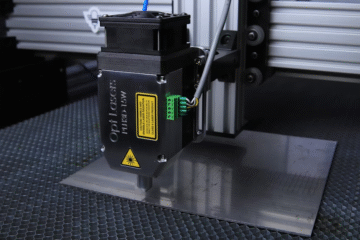Optical Computing Makes One Million Times Faster Data Processing

A new approach to optical computing could lead to data processing that is a million times faster than current technology, say researchers. The new technique uses light instead of electricity to perform calculations and could pave the way for ultrafast processors and computer memory. In current computers, data is processed using transistors that switch electrical signals on and off. However, as electronic components get smaller, they are reaching their physical limits. Optical computing could provide a solution as it uses mirrors and other photonic elements to control beams of light, which can carry much more information than electrical signals.
What is optical computing?
Optical computing is a type of computing where data is processed using light instead of electricity. This technology has the potential to be much faster than traditional electronic computers.
Traditional computers use electrical signals to represent data and perform calculations. These signals travel through wires and are subject to various types of interference. Optical computing, on the other hand, uses light to represent data. This means that the data can be transmitted without wires and is not subject to interference.
The main benefit of optical computing is speed. Light can travel much faster than electricity, so an optical computer can potentially perform calculations much faster than a traditional computer. There are also other potential benefits, such as lower power consumption and improved security.
However, there are also some challenges associated with optical computing. One challenge is that it can be difficult to control light at the required level of precision. Another challenge is that current optical components are not compatible with existing electronic components. This means that new infrastructure would need to be created in order to support optical computing.
Despite the challenges, optical computing has the potential to revolutionize the world of computing. This technology is still in its early stages of development, but it has already shown great promise.
How is this new approach different?
The new approach to optical computing is based on a phenomenon known as the photonic Aharonov-Bohm effect. This effect can be used to create extremely fast and efficient optical computers that are millions of times faster than current technology. The Aharonov-Bohm effect occurs when light waves interact with each other in a way that creates a “quantum interference” pattern. This interference pattern can be used to encode information in an extremely dense and efficient manner. The new approach to optical computing is able to take advantage of this effect to create ultrafast processing speeds.
What are the benefits of ultrafast processing?
In our daily lives, we are constantly interacting with technology that is reliant on ultrafast processing. From the computers we use to the mobile devices we carry with us everywhere, these devices all rely on processors that can handle large amounts of data very quickly.
While the speed at which these processors operate is impressive, there is always room for improvement. A new approach to optical computing has the potential to offer processing speeds that are one million times faster than what is currently possible.
What would be the implications of such a significant increase in processing speed? For starters, it would mean that we could process large amounts of data much more quickly. This could be used to make better decisions in real-time or to process massive amounts of data for things like weather forecasting or climate modeling.
The benefits of this technology go beyond just improving our ability to process information. Ultrafast processing could also lead to advances in fields like artificial intelligence and machine learning. By being able to process large amounts of data more quickly, these systems would be able to learn and evolve at a much faster pace.
All of this points to a future where ultrafast processing plays a central role in many aspects of our lives. It is an exciting time for those working on this technology, and the potential benefits for society are immense.
What are the potential applications of this technology?
This technology has the potential to revolutionize computing. It could enable ultrafast processing speeds and allow for the development of new applications that are not possible with current technology. This approach could be used to create optical computers that are smaller, faster, and more energy-efficient than today’s computers. Additionally, this technology could be used to develop new medical imaging techniques, create more realistic computer simulations, and improve communications systems.
When will this technology be available?
This new optical computing technology is still in development, and it is not yet clear when it will be available for commercial use. However, the researchers believe that it has great potential and could be available within a few years.
Read Also: Stunning Technology Trends In 2023
How optical computing works
Optical computing is a form of computing where data is processed using light instead of electricity. This means that optical computers can process information much faster than traditional computers.
How does optical computing work? Optical computers use an array of mirrors to reflect and redirect beams of light. These beams of light are used to represent data, which can be manipulated by the mirrors to perform calculations. Because mirrors can move very quickly, optical computers can perform calculations much faster than traditional computers.
One advantage of optical computing is that it is very energy efficient. Traditional computers require a lot of electricity to run, but optical computers only need a small amount of power to function. This makes optical computing a very attractive option for powering large-scale computational tasks.
Another advantage of optical computing is that it produces no heat. This is because there are no moving parts in an optical computer, so there is no friction or other sources of heat generation. This makes optical computers ideal for use in environments where heat dissipation is a concern, such as in data centers
The benefits of optical computing
Optical computing has the potential to revolutionize the way we process information. This technology offers many benefits over traditional electronic computers, including speed, energy efficiency, and lower costs.
Traditional electronic computers use a series of switches to turn electrical signals on and off. This process is relatively slow and uses a lot of energy. Optical computing takes advantage of the fact that light can be turned on and off very rapidly. Using this property, optical computers can perform calculations at speeds that are orders of magnitude faster than current electronic computers.
In addition to being much faster, optical computers also have the potential to be more energy efficient than their electronic counterparts. Because they don’t rely on electrical signals, they don’t generate as much heat, which means they require less power to operate. This could lead to significant reductions in our reliance on fossil fuels for computing purposes.
Finally, optical computing technology is expected to be less expensive than traditional electronic computing technology. The main reason for this is that optical components are becoming increasingly commonplace in a variety of industries (e.g., telecommunications), which has driven down the cost of these components. In addition, because optical computers don’t require complex cooling systems like electronic computers do, they should be cheaper to manufacture overall.
Current applications of optical computing
As electronic components continue to miniaturize, the speed at which they operate is also increasing. However, there are physical limitations to how small and how fast these components can get. This has led scientists to explore other ways of computing, such as using light instead of electricity.
Optical computing has the potential to be much faster than traditional electronic computing. This is because light can travel much faster than electrons, so information can be processed more quickly. Additionally, optical components can be much smaller than their electronic counterparts, so more could fit onto a single chip.
There are currently several different approaches to optical computing under development. One promising approach is using nanoscale silicon photonic devices. These devices can generate and manipulate light on a very small scale, making them ideal for use in optical computers.
So far, researchers have demonstrated that this approach can achieve speeds of up to one million operations per second. This is a significant improvement over current electronic computers, which typically operate at speeds of only a few gigahertz (billions of operations per second).
The high speed and small size of nanoscale silicon photonic devices make them attractive for use in a wide range of applications. They could be used in superfast computers for scientific and engineering applications, or in large data centers where speed is critical. They could also be used in consumer devices such as smartphones and tablets, where space is limited but processing power is still important.
The future of optical computing
The future of optical computing is looking very bright. Researchers have developed a new approach to optical computing that is one million times faster than current technology. This new approach uses a nanoscale photonic device to perform calculations at the speed of light.
This new technology could revolutionize the way we process information. Optical computers could be used to solve complex problems that are currently too difficult for traditional computers. They could also be used to process large amounts of data very quickly.
The potential applications for this new technology are endless. We are just beginning to scratch the surface of what is possible with optical computing. The future is looking very bright for this exciting new field.
Conclusion
While current optical computing technology is impressive, this new approach offers the potential for even greater speed and efficiency. If successfully developed, it could revolutionize the way we process information and enable a wide range of new applications. We’ll be keeping an eye on this one!




